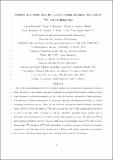Cement As a Waste Form for Nuclear Fission Products: The Case of ⁹⁰Sr and Its Daughters
Author(s)
Kohanoff, Jorge J.; Correa, Alfredo A.; Caro, Alfredo; Dezerald, Lucile; Pellenq, Roland Jm; Ulm, Franz-Josef; Conesa-Labastida, Andres; ... Show more Show less
Downloadcement_postprint.pdf (961.9Kb)
PUBLISHER_POLICY
Publisher Policy
Article is made available in accordance with the publisher's policy and may be subject to US copyright law. Please refer to the publisher's site for terms of use.
Terms of use
Metadata
Show full item recordAbstract
One of the main challenges faced by the nuclear industry is the long-term confinement of nuclear waste. Because it is inexpensive and easy to manufacture, cement is the material of choice to store large volumes of radioactive materials, in particular the low-level medium-lived fission products. It is therefore of utmost importance to assess the chemical and structural stability of cement containing radioactive species. Here, we use ab initio calculations based on density functional theory (DFT) to study the effects of90Sr insertion and decay in C-S-H (calcium-silicate-hydrate) in order to test the ability of cement to trap and hold this radioactive fission product and to investigate the consequences of its β-decay on the cement paste structure. We show that ⁹⁰Sr is stable when it substitutes the Ca²⁺ ions in C-S-H, and so is its daughter nucleus ⁹⁰Y after β-decay. Interestingly,⁹⁰Zr, daughter of ⁹⁰Y and final product in the decay sequence, is found to be unstable compared to the bulk phase of the element at zero K but stable when compared to the solvated ion in water. Therefore, cement appears as a suitable waste form for ⁹⁰Sr storage.
Date issued
2015-11Department
Massachusetts Institute of Technology. Department of Civil and Environmental EngineeringJournal
Environmental Science & Technology
Publisher
American Chemical Society (ACS)
Citation
Dezerald, Lucile et al. “Cement As a Waste Form for Nuclear Fission Products: The Case of ⁹⁰Sr and Its Daughters.” Environmental Science & Technology 49, 22 (October 2015): 13676–13683 © 2015 American Chemical Society
Version: Author's final manuscript
ISSN
0013-936X
1520-5851